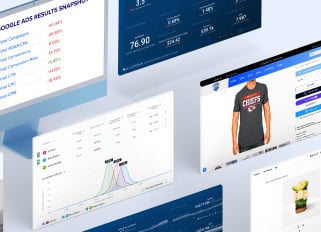
SEO for Shopify: 9-Step Guide to Boost Organic Rankings
Are you aiming to boost your Shopify store's visibility and attract more organic traffic? The secret to success lies in search engine optimization (SEO), a strategic approach to making your store more search-engine friendly.
Our detailed 9-step Shopify SEO guide offers Shopify users an all-encompassing strategy to elevate their organic search rankings effectively. By applying our advanced SEO techniques, you can significantly enhance your online presence, draw in more potential customers, and ultimately achieve higher sales and business growth.
What is Shopify SEO?
Shopify SEO is optimizing a Shopify online store for search engines to increase visibility, attract traffic, and improve sales. It involves a strategic blend of techniques that make your store more search-engine friendly, from optimizing site structure and improving user experience to leveraging keywords appropriately and creating high-quality, relevant content.
The goal is to ensure your store appears prominently in search results when potential customers look for the products or services you provide, allowing you to stand out in a competitive digital marketplace.
Benefits of SEO for Your Shopify Store
Millions of online stores compete globally, making it essential for your Shopify store to achieve a high ranking on Google and other search engines. By applying effective SEO strategies, your Shopify store can enjoy a myriad of benefits, enhancing its visibility and success.
- Increased Organic Traffic: Optimal SEO practices enhance your site's visibility on search engine results pages (SERPs), driving a significant uptick in organic traffic. By targeting relevant keywords your potential customers are searching for, you increase the likelihood of attracting interested visitors to your site.
- Cost-Effectiveness: Compared to paid advertising, SEO is a cost-effective strategy to generate traffic. While paid campaigns require continuous funding to keep traffic flowing, a well-optimized SEO strategy provides sustained organic traffic over time, offering a better return on investment.
- Enhanced User Experience: SEO involves improving the structure and navigation of your Shopify store, making it easier for visitors to browse and find the products or information they seek. A seamless user experience encourages longer site visits, which can lead to increased engagement and sales.
- Higher Conversion Rates: Targeted traffic has a higher potential for conversion since SEO helps attract visitors with the intent to purchase. Optimizing your store for relevant keywords positions your products in front of consumers who are already interested in what you offer, increasing your conversion rate.
- Improved Credibility and Trust: Websites that appear higher in search results are often perceived as more trustworthy and credible by users. By securing a top position in SERPs, your Shopify store can gain credibility with your audience, fostering trust in your brand.
- Competitive Advantage: Ranking higher than your competitors in search results can give you a competitive edge. SEO enables you to outperform competitors by ensuring your store is more visible and appealing to potential customers.
- Long-Term Growth: SEO is not a one-time investment; it's an ongoing strategy that contributes to the long-term growth of your online store. The cumulative effect of continued SEO efforts can result in sustained organic traffic growth, increased brand recognition, and ongoing sales improvement.
How to Do SEO for Shopify: 9 Steps to Success
Now that you understand the benefits of optimizing your Shopify store for search engines let's dive into our comprehensive 9-step guide to help you get started on your journey toward improved organic rankings.
Step 1: Conduct a Comprehensive Keyword Research
Comprehensive keyword research is a foundational element of a successful Shopify SEO strategy. It involves identifying the terms and phrases potential customers use when searching for products or services related to your business. Here's how you can perform effective keyword research for your Shopify store:
Identify Your Core Keywords
Start by listing the core terms describing your business, products, and services. These should be the key concepts and categories that represent what you offer.
Use Keyword Research Tool
Leverage keyword research tools such as Google Keyword Planner, Semrush, Ahrefs, or Moz Keyword Explorer. These tools can help you discover relevant keywords, their search volume, competition level, and related search terms that you may not have considered.
Analyze Competitor Keywords
Review your competitors' online stores and use SEO tools to uncover their targeted keywords. Analyzing how search engines index your competition can reveal valuable insights into effective keywords and gaps in their strategies that you can exploit.
Focus on Long-Tail Keywords
Long-tail keywords are more specific and often closer to what your potential customers are typing into search engines like Google. Due to their specificity, these keywords typically have lower search volumes but higher conversion rates.
Consider Search Intent
Understanding the searcher's intent behind keywords is crucial. Keywords can be categorized into informational, navigational, transactional, and commercial investigation. Tailoring your content to match the intent of the keywords can significantly improve your blog post or page's relevancy and attractiveness to potential customers.
.jpg?width=600&height=400&name=a-team-of-young-multinational-business-people-are-2023-11-27-05-04-52-utc%20(1).jpg)
Keep an Eye on Trends
Leverage tools like Google Trends to monitor keyword popularity over time. By doing so, you can identify and capitalize on emerging trends ahead of others, refining your keyword strategy to maintain a competitive edge.
Organize and Prioritize Keywords
Once you have a comprehensive list of keywords, organize them by relevance, search volume, and competition. Prioritize keywords that are highly relevant to your offerings and have significant search volumes but relatively low competition, striking a balance between demand and your ability to compete.
Integrate Keywords across Your Shopify Store
Finally, strategically integrate your chosen keywords throughout your Shopify store. This includes page titles, product titles and descriptions, meta titles and descriptions, URLs, and content such as blog posts and buying guides.
Remember, keyword integration should always feel natural and enhance the readability of your content, never compromising on user experience.
Step 2: Optimize Your Shopify Stores On-Page SEO
Optimizing your Shopify stores on-page SEO is crucial for improving online visibility. This process involves refining individual web pages to rank higher and attract more relevant traffic. Here are key strategies to enhance your store's on-page SEO:
Optimize Your Title Tags and Meta Descriptions
Ensure each page has a unique title tag and meta description that accurately describes the page's content while incorporating your target keywords.
The title tag should be concise, ideally under 60 characters, while the meta description should offer a brief overview of the page, enticing users to click, and stay under 160 characters.
Improve Your URL Structure
Create clear, readable URLs that include primary keywords for each page. Avoid complex or lengthy URLs; instead, strive for simplicity and relevance, making it easier for search engines and users to understand the page content.
Enhance Your Product Pages and Category Pages
To optimize your product pages, include high-quality images with alt text, product descriptions, and customer reviews. For category pages, use descriptive headings and organize products logically to improve user experience and search engine crawling.
Use Header Tags Properly
Organize content on your pages using header tags (H1, H2, H3, etc.) to improve readability and help search engines understand the structure of your content. The H1 tag is particularly crucial for indicating what a page is about, so use it to encapsulate the main topic of each page using relevant keywords.
Leverage Schema Markup
Incorporate schema markup (structured data) into your website to enable search engines to interpret your page content more accurately, thereby improving your visibility in search results (e.g., via rich snippets). This strategy can boost click-through rates by offering users detailed insights into what your page offers.
Optimize Page Load Speed
Page load speed is a significant ranking factor. To speed up your site, optimize images, leverage browser caching, and minimize JavaScript and CSS files. Consider using tools like Google PageSpeed Insights to identify and rectify issues that could slow down your e-commerce site.
(More on this in the section below!)
Ensure Mobile Responsiveness
With an increasing number of users shopping on mobile devices, it's crucial to ensure your Shopify store is mobile-friendly. A responsive design adapts your content to various screen sizes, improving user experience and SEO.
Content Optimization
Update your site regularly with high-quality, relevant content that includes your target keywords. Creating new blog posts, buying guides, and frequently updating old content and product pages can keep your content fresh and engaging for both users and search engines.
Internal Linking Strategy
Improve your site's navigation and SEO by strategically using internal links to connect your content. This approach helps with search engine indexing and provides value to your website visitors by guiding them to relevant, related content.
Step 3: Enhance Your Site’s Loading Speed
Enhancing your Shopify stores page loading speed is critical for both user experience and search engine optimization. A fast-loading site can decrease bounce rates and improve overall engagement, leading to higher conversion rates. Follow the strategies mentioned below to optimize your store’s loading speed:
Use Compressed Images and Videos
Large image and video files can significantly slow down page loading times. Compress your images before uploading them to your store using tools like Adobe Photoshop or online services such as TinyPNG, ensuring they are optimized for the web without compromising quality.
Minimize the Use of Redirects
Each redirect can cause extra HTTP request-response cycles, thereby increasing load time. Minimize the use of redirects within your site to essential ones, reducing unnecessary delays in content delivery.
Leverage Browser Caching
By enabling browser caching, you can store certain parts of your store's data on visitors' devices, meaning less data is transferred over the network for subsequent visits. This can drastically reduce loading times for repeat visitors.
Optimize JavaScript and CSS Files
Minify and combine your JavaScript and CSS files to reduce the number of requests your site makes and the size of those files, speeding up page load times. Various tools are available online to help with minifying these files.
Use a Content Delivery Network (CDN)
A CDN can distribute your store's content across multiple geographically diverse servers, ensuring your pages are loaded from the closest server to a site visitor. This can significantly reduce loading times for users regardless of their location.
Choose a Fast and Responsive Shopify Theme
Select a theme designed for speed and performance. Themes with minimalistic designs and optimized code can load faster than those with complex layouts and numerous features.
Eliminate Unnecessary Shopify Apps
Every app installed can increase your site's load time. Review and uninstall any Shopify apps that are not essential to your store’s operation or customer experience regularly.
Avoid Using Too Many Web Fonts
Web fonts can enhance your site's design, but using too many different fonts can slow down your page load times. Stick to a minimal set of web fonts and ensure they are optimized for the web.
Regularly Test Your Site’s Speed
Use tools like Google PageSpeed Insights, GTmetrix, or Pingdom to test your Shopify store's speed regularly. These tools can provide valuable insights and specific recommendations for further improvements.
Is Shopify Speed Score Useful?
In 2020, Shopify introduced a site speed feature designed to show the loading speed of your Shopify store from the moment a user visits a page to the point it fully loads. While this can be a useful metric for gauging overall landing speed, it should not be the sole focus of your optimization efforts.
This score is largely derived from Google's Lighthouse performance metrics, which means it focuses on various factors, from page speed to mobile friendliness. However, it does not consider other vital aspects, such as user experience and conversion rates. A high-speed score does not necessarily guarantee a high-converting site, and vice versa.
Step 4: Ensure Mobile-Friendliness
Optimizing your Shopify store for mobile users is imperative in today's increasingly mobile-first world. A significant portion of online shopping is done on mobile devices, making mobile responsiveness a critical aspect of your online presence. To optimize your Shopify store for mobile, follow these guidelines:
- Choose a Responsive Theme: Make sure to select an inherently responsive Shopify theme. This ensures your e-commerce site will automatically adjust to fit the screen size of any device, providing an optimal viewing experience for users no matter the device used.
- Simplify Navigation: Mobile users should be able to browse your store and find what they need easily. Simplify your website's navigation using a clear, concise menu and a prominent search bar. Avoid cluttered menus that can be frustrating to use on smaller screens.
.jpg?width=600&height=400&name=cheerful-woman-pointing-with-pen-at-laptop-while-s-2023-11-27-04-51-24-utc%20(1).jpg)
- Optimize Images and Videos: Ensure all visual elements load quickly and are displayed correctly on mobile devices. Use compressed images and responsive video embeds that adjust size based on the screen.
- Test Mobile Performance: Use mobile-specific testing tools like Google's Mobile-Friendly Test to analyze your store's performance on mobile devices. Pay attention to loading speeds and user experience and make necessary adjustments.
- Minimize Pop-Ups: While pop-ups can be useful for desktop users, they can be intrusive and annoying on mobile devices. If you must use them, ensure they are easy to dismiss and do not interrupt the mobile shopping experience.
- Fast and Easy Checkout: Streamline the checkout process as much as possible. Mobile users appreciate quick, hassle-free transactions. Consider enabling accelerated checkout methods and ensure form fields are optimized for mobile input.
- Mobile SEO: Implement mobile SEO best practices to improve your store's visibility in mobile search results. This includes using mobile-friendly URLs, optimizing titles and meta descriptions for mobile, and ensuring your site's content is easily crawlable by search engine bots.
Step 5: Build High-Quality Backlinks
Backlinks, links from other websites to your site, serve as a critical indicator of your website’s credibility and authority to search engines.
A higher quantity of reputable backlinks signals to search engines that your content is valuable and trustworthy, thereby improving your search engine ranking. This is particularly important for e-commerce platforms like Shopify, where visibility in search results can significantly impact traffic and sales.
Furthermore, link building enhances your site's visibility and attracts direct traffic from other websites, broadening your audience and potential customer base. However, monitoring for broken links is crucial, as they can detrimentally impact your website's performance and search engine optimization.
Step 6: Leverage Social Media for SEO
While social signals may not directly influence rankings, a strong social media presence can amplify your content and lead to more backlinks.
Share your content across your social media platforms, engage with your followers, and utilize hashtags to increase your content’s reach and visibility. This strategy, in turn, can improve your website’s overall search engine ranking and drive traffic to your Shopify store.
Furthermore, consistently monitoring social media for brand mentions can help you maintain a positive online reputation and address potential issues before they escalate.
Step 7: Implement a Content Marketing Strategy
Implementing a content marketing strategy for a Shopify store involves a series of well-planned steps designed to attract, engage, and retain an audience by creating and sharing relevant articles, videos, podcasts, and other media. This approach establishes expertise, promotes brand awareness, and ensures your business remains a preferred choice for consumers at the time of purchase.
Here’s how to start:
- Define Your Target Audience: Understand who your customers are, their needs, their problems, and how your products or services provide a solution. Creating buyer personas can be a helpful way to accomplish this.
- Set Clear Goals: Determine what you want your content marketing efforts to achieve. Is it to increase traffic, boost sales, enhance brand awareness, or build customer loyalty? Your goals will guide your content strategy.
- Conduct Keyword Research: Find out what keywords and phrases your target audience uses when searching for products or information online. Incorporate these keywords into your content to improve SEO and drive traffic to your site.
- Create a Content Calendar: Plan your content creation and publication schedule. A content calendar helps ensure consistent content production and can help you plan for key events or product launches.
- Produce High-Quality Content: Create valuable, informative content that aligns with your audience’s interests. Some examples are blog posts, tutorials, product guides, videos, and infographics. High-quality content can establish your authority in your niche and improve your SEO rankings.
- Optimize for SEO: Ensure your content is optimized for search engines to improve visibility. Use keywords naturally, optimize your images, and structure your content with headers to make it easier to read.
- Promote Your Content: Share your content on social media, with your email subscribers, and on other channels where your audience spends time. Promotion is key to driving traffic to your new content.
- Measure and Adjust: Use analytics to track the performance of your content. Look at metrics like page views, engagement, and conversion rates to understand what works and what doesn’t. Use these insights to improve your content strategy continuously.
Step 8: Utilize Shopify SEO Apps and Tools
Shopify offers built-in SEO features to help store owners optimize their websites for search engines. These features include customizable titles and meta tags, automatic sitemap generation, and mobile-friendly themes.
However, if you want to take your Shopify stores SEO to the next level, these apps and tools can help:
- SEO Manager: This app allows you to optimize your website's title tags, meta descriptions, and image alt tags in bulk, saving time and effort.
- Plug-in SEO: This app scans your store for common SEO mistakes and offers recommendations for fixing them.
- Semrush: Semrush is a comprehensive SEO tool that can help with target keyword research, site audits, backlink analysis, and more.
- Google Analytics: Google Analytics is a powerful tool that provides insights into your website's traffic and performance.

Step 9: Measure and Adjust Your SEO Strategy
After optimizing your Shopify store for SEO, it's crucial to monitor and analyze the outcomes of your strategies. This monitoring process enables you to discern the effectiveness of your efforts and identify areas that require enhancement.
Leverage tools such as Google Analytics and Google Search Console for valuable insights into your SEO performance. Additionally, keep a close eye on your search engine rankings for target keywords, which serve as a barometer for your SEO approach's success. Should you observe a decline in rankings, it's a signal to reassess and refine your strategy.
Conclusion
Boosting your Shopify store's organic rankings requires a strategic and ongoing effort. By implementing the steps outlined in this guide, you can improve your store’s visibility, drive targeted traffic, and, ultimately, increase sales.
Note: While this guide covers the essential steps for SEO on Shopify, it is always recommended to consult an SEO professional or do further research for more specific or advanced strategies. SEO is a complex and ever-changing field, and continuous learning and adaptation are key to staying ahead of the game. Looking for an e-commerce marketing agency? Contact our team of SEO experts at BlueTuskr to discuss an e-commerce SEO service that's right for your business.
Connect With Us
Recent Post

.png)








Tell us what you think!